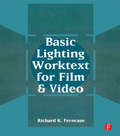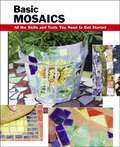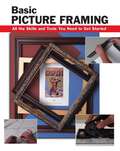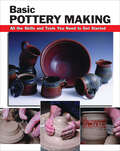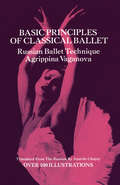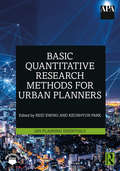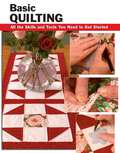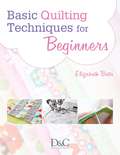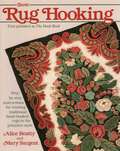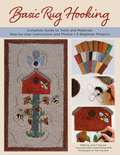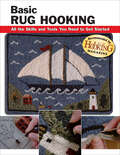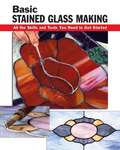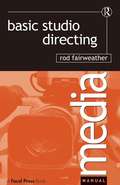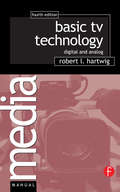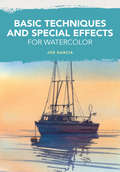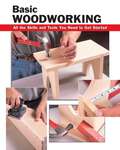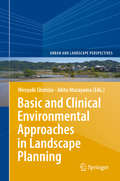- Table View
- List View
Basic Knitting and Projects
by Leigh Ann ChowEverything you need to get started knitting--and progress to more challenging projects--can be found in this book.
Basic Leathercrafting (How To Basics)
by Elizabeth LetcavageStep-by-step instructions and photos illustrate basic leathercrafting techniques: choosing leather, stamping and decorating, stitching and lacing, and finishing.
Basic Lighting Worktext for Film and Video
by Richard FerncaseBasic Lighting Worktext for Film and Video guides the film and video student through a series of readings, exercises and projects designed to provide the fundamentals of light science. In addition to up-to-date descriptions of equipment and tips on how to use it properly, the book provides numerous set-ups that illustrate the techniques and thoughts behind proper studio and location lighting. From this book, you will learn:* The fundamentals of light and electricity in film* The fine distinction of lighting for video versus lighting for film* How to identify and filter sources such as daylight, tungsten, fluorescent, arc, HNI and industrial discharge lamps* The use of lensed and open-faced lighting fixtures* How to modify with barndoors, scrims, snoots, nets, cookies, and other accessories* Variations on the basic three-point lighting setup* The duties of each member of a lighting unit* How to light night exteriors, day interiors, and campfires* High-key, low-key, and modulated value lighting* How to scout locations, plan lighting, plots, and pre-rig sets
Basic Mosaics (How To Basics)
by Martin Webb Sherrye LandrumMake mosaic frames, decorative panels, tabletops, shelves, switch plates, pavers, bird houses, and more. A creative way to remake and reuse household items. Includes a gallery of colorful finished pieces and details on 20 different projects.
Basic Perspective Drawing
by John MontagueThe best-selling guide...now completely updated to include online tutorials!Basic Perspective Drawing introduces students, both those in formal design courses and self-learners, to the basic principles and techniques of perspective drawing. Clear and accessible illustrations show how to construct perspective views one step at a time. The new, streamlined Sixth Edition contains must-have content for students and instructors in art and design, architecture, and interior design programs. Updated illustrations reflect the most current drawing styles and examples while supplementary tutorial videos, grouped by architectural disciplines, interior design, and studio art/illustration, provide live-action demonstrations of key topics discussed in the book.
Basic Photographic Materials and Processes
by Nanette L. Salvaggio Josh ShagamBasic Photographic Materials and Processes describes the three crucial stages of creating the perfect photograph—capture, processing and output—by providing a thorough technical investigation of modern, applied photographic technologies. This new edition has been fully revised and updated to explore digital image capture, processing and output. It covers a wide range of topics including: the scientific principles of measuring and recording light, the inner workings of digital cameras, image processing concepts, color management and photographic output to screen and print media. With these topics come in-depth discussions of extending dynamic range, image histograms, camera characterization, display capabilities, printer and paper technologies. It also includes applied exercises that provide the reader with a deeper understanding of the material through hands-on experiments and demonstrations, connecting theoretical concepts to real-world use. This comprehensive text provides photography students, educators and working professionals with the technical knowledge required to successfully create images and manage digital photographic assets. It is an essential resource for mastering the technical craft of photography.
Basic Picture Framing (How To Basics)
by Amy CooperStep-by-step instructions for matting, mounting, and framing. Color photos illustrate each step. Includes sections on mounting needlework, framing canvases, and building your own frame.
Basic Pottery Making: A Complete Guide
by Mark FitzgeraldLearn the tools and techniques you need to start making ceramic mugs, bowls, and more!Step-by-step instructions complete with color photographsIncludes a chapter on bisque firing, waxing, and glazing4 basic pottery projects for the beginning potterThe art of pottery making is described in detail for the beginning potter. Complete with a chapter on tools and materials to get started, this easy-to-use guide explains and illustrates how to wedge clay, use a pottery wheel, shape and trim pots, determine clay thickness, add handles, and a host of other pottery-making techniques. It also contains a chapter on bisque firing and glazing, the final steps in creating beautiful and functional pottery. Includes complete instructions for making a large bowl, three styles of mugs, and a sugar bowl and creamer set.
Basic Pottery Making: All the Skills and Tools You Need to Get Started (How To Basics)
by Linda FranzAn illustrated guide to the fundamentals of pottery making with straightforward, expert instruction and four projects for the beginner potter. Complete with a chapter on tools and materials to get started, this easy-to-use guide explains and illustrates how to wedge clay, use a pottery wheel, shape and trim pots, determine clay thickness, add handles, and a host of other pottery-making techniques. It also contains a chapter on bisque firing and glazing, the final steps in creating beautiful and functional pottery. Includes complete instructions for making a large bowl, three styles of mugs, and a sugar bowl and creamer set.
Basic Prediction Techniques in Modern Video Coding Standards (SpringerBriefs in Electrical and Computer Engineering)
by Byung-Gyu Kim Kalyan GoswamiThis book discusses in detail the basic algorithms of video compression that are widely used in modern video codec. The authors dissect complicated specifications and present material in a way that gets readers quickly up to speed by describing video compression algorithms succinctly, without going to the mathematical details and technical specifications. For accelerated learning, hybrid codec structure, inter- and intra- prediction techniques in MPEG-4, H. 264/AVC, and HEVC are discussed together. In addition, the latest research in the fast encoder design for the HEVC and H. 264/AVC is also included.
Basic Principles of Classical Ballet: Russian Ballet Technique
by Agrippina VaganovaAlthough the stars of Russian ballet Anna Pavlova and Tamara Karsavina possessed a national manner of dancing, there was no truly Russian school of dancing until the 1930s. The development of this school was largely due to Mme. Vaganova (1879–1951), not only a great dancer but also the teacher of Galina Ulanova and many others and an unsurpassed theoretician.The principles of Vaganova's system are presented in this well-known book. Mme. Vaganova's aim of creating a personal approach to the Russian dance was based on the critical assimilation of the experience of her contemporaries. Her ability to choose the best of what had been accomplished in the various ballet traditions (French, Italian, and Russian) and combine these into a unified teaching practice in itself amounted to a new school of dance. She firmly believed that the teaching process should be a planned exercise, ever changing with innovations in the dance. She sought from her pupils emotional expressiveness, strictness of form, a resolute, energetic manner of performance, and the understanding of the underlying coordination of movements.Her book discusses all basic principles of ballet, grouping movements by fundamental types. Chapters cover battements, rotary movements of the legs, the arms, poses of the classical dance, connecting and auxiliary movements, jumps, beats, point work, and turns as well as material for a sample lesson. Diagrams show clearly the exact foot, leg, arm, and body positions for the proper execution of many steps and movements. The result is a fundamental theory of dance that offers dancers, teachers, and ballet lovers information often difficult to locate in other books. 118 illustrations.
Basic Quantitative Research Methods for Urban Planners (APA Planning Essentials)
by Reid Ewing Keunhyun ParkIn most planning practice and research, planners work with quantitative data. By summarizing, analyzing, and presenting data, planners create stories and narratives that explain various planning issues. Particularly, in the era of big data and data mining, there is a stronger demand in planning practice and research to increase capacity for data-driven storytelling. Basic Quantitative Research Methods for Urban Planners provides readers with comprehensive knowledge and hands-on techniques for a variety of quantitative research studies, from descriptive statistics to commonly used inferential statistics. It covers statistical methods from chi-square through logistic regression and also quasi-experimental studies. At the same time, the book provides fundamental knowledge about research in general, such as planning data sources and uses, conceptual frameworks, and technical writing. The book presents relatively complex material in the simplest and clearest way possible, and through the use of real world planning examples, makes the theoretical and abstract content of each chapter as tangible as possible. It will be invaluable to students and novice researchers from planning programs, intermediate researchers who want to branch out methodologically, practicing planners who need to conduct basic analyses with planning data, and anyone who consumes the research of others and needs to judge its validity and reliability.
Basic Quilting (How To Basics)
by Sherrye LandrumWell-chosen beginning projects develop your quilting skills without requiring a long time to complete. Expert advice on choosing fabric, batting, backing, thread, and quilt designs. Complete instructions and photos for creating a pot holder, tote bag, pillow cover, and table runner.
Basic Quilting Techniques for Beginners
by Elizabeth BettsLearn the basics of quilting, from paper piecing and appliqué to hand and machine quilting. Features 16 simple projects, each focusing on a different technique, from bags and cushions, to table mats, wall hangings and different-sized quilts. Clear illustrations accompany simple step-by-step instructions, making every project suitable for complete beginners.
Basic Rug Hooking
by Alice Beatty Mary SargentRevised and updated, the standard introduction to making wool rugs with the traditional handheld hook. Originally published as The Hook Book.
Basic Rug Hooking: * Complete guide to tools and materials * Step-by-step instructions and photos * 5 beginner projects
by Janet Stanley ReidLearn to hook with easy step-by-step photos!Rug hooking at its simplest is pulling loops of colorful wool fabric through a piece of linen backing to create beautiful designs for the floor or wall. Though in years past this was accomplished with a bent nail, a feed bag, and worn-out clothing, today we have specialized hooks and other tools that make the process much easier. In Basic Rug Hooking, you will learn what tools and materials you need to get started, and how to pull your first loops. Once you've learned and practiced the basics, you will be ready to try any of the 5 hooked projects included. Each project includes the pattern and complete step-by-step illustrated instructions. The styles of rugs you can make once you've learned the basic hooking process are endless. Rug hookers today create traditional florals, bright geometrics, pictorials, portaits, and primitives perfect for the modern farmhouse. Basic Rug Hooking teaches you everything you need to know to start hooking today!
Basic Rug Hooking: All the Skills and Tools You Need to Get Started (How To Basics)
by Judy P SopronyiA comprehensive primer that will have you hooking your way through simple to more difficult projects—with step-by-step photos! Rug hooking at its simplest is pulling loops of colorful wool fabric through a piece of linen backing to create beautiful designs for the floor or wall. Though in years past this was accomplished with a bent nail, a feed bag, and worn-out clothing, today we have specialized hooks and other tools that make the process much easier. In Basic Rug Hooking, you will learn what tools and materials you need to get started, and how to pull your first loops. Once you&’ve learned and practiced the basics, you will be ready to try any of the five hooked projects included. Each project includes the pattern and complete step-by-step illustrated instructions. The styles of rugs you can make once you&’ve learned the basic hooking process are endless. Rug hookers today create traditional florals, bright geometrics, pictorials, portraits, and primitives perfect for the modern farmhouse. Basic Rug Hooking teaches you everything you need to know to start hooking today!
Basic Sewing for Costume Construction
by Rebecca C. CunninghamAll students of costuming need to learn basic sewing techniques to build costumes for theatrical performance. Basic Sewing for Costume Construction teaches just those fundamentals. Cunningham brings decades of classroom experience as she guides readers with clearly laid-out projects covering hand stitching, fasteners, pinning, sewing, and seams. Additional material on measurement, fabric selection, and use of commercial patterns, as well as three complete construction projects, round out the Second Edition. Each project builds on the previous one to develop a full understanding of the costume construction process.
Basic Soap Making (How To Basics)
by Elizabeth LetcavageHundreds of step-by-step, full-color photographs illustrate exactly how to make cold-process soap. Instructions on molding soap, cutting bars, creating original recipes, packaging gifts, and more. Includes a chapter on constructing a soap mold, liner, and cutter at home.
Basic Stained Glass Making (How To Basics)
by Eric EbelingEach technique illustrated with color photos. Complete explanation of tools and materials. Step-by-step lessons for a variety of projects.
Basic Studio Directing
by Rod FairweatherAll studio directors need to know the basics of studio directing, whether they go on to direct news, drama, children's programmes or light entertainment. Learning the ropes on air can be costly: this book gives you all the practical and technical guidance you need to deliver a trouble free programme. All studio directors need to know the basics of studio directing, whether they go on to direct news, drama, children's programmes or light entertainment. Learning the ropes on air can be costly: this book gives you all the practical and technical guidance you need to deliver a trouble free programme.Starting with an emphasis on the skills that make a good director, the essential day to day know-how is outlined - from different presentation formats to the roles of the production team, camera technology, composition, lighting, digital video, chroma key, make-up and wardrobe. Whether you are a student or practitioner wishing to sharpen up your technique, this manual is an excellent guide to the technology and skills required.This book:· Provides essential day to day information in one handy source · Offers a combination of theory and practice, technical data and intuitive skill· Is an excellent introductory text for anyone embarking on a career in directingContents:Networks * Cameras and Pictures * Pre-Production * Cutting and Combining Pictures * The Studio Team * Interviews * Magazines * Script Layouts * Electronic Newsrooms * Practical Directing * Communications * Directors Technology * Dealing with Problems.Rod Fairweather is a freelance director and has worked for companies such as SKY TV, GMTV, ITN and MTV Europe. He conducts training courses on directing all over the world including Singapore, India and Australia.
Basic TV Technology: Digital and Analog (Media Manual Ser.)
by Robert L HartwigBasic TV Technology is the essential basic guide to the fundamentals underlying all television and video systems, written for students and nontechnical professionals. You don't need to have a math or science background in order to understand this explanation of how the principal pieces of equipment work, what their functions are, and how they are integrated to form a complex video system. An understanding of this material will be necessary for you to succeed in the real world, where one person often has to perform many different roles and functions within a production. Armed with some basic technical background information, you'll be more effective at figuring out new applications and at problem-solving. The fourth edition of Basic TV Technology has been updated to reflect the industry shift to digital video and includes new information on compression, television standards, LCD displays, HD, and equipment. This book features the accessible Media Manual format, in which every topic is covered in two pages: one of explanatory text and one of figures. Need more information on TV technologies, go to: http://www.insightmedia.info/newsletters.php
Basic Techniques and Special Effects for Watercolor
by Joe GarciaTake your watercolor paintings to the next level with these great techniques. Build a foundation with basic techniues like using wet-into-wet washes and glazing and layering before moving right along to using blooms, backruns, salt and wax to create great effects. Not only will you create gorgeous paintings, but you'll have fun doing them.
Basic Woodworking
by Cheryl SobunA fully illustrated introduction to hand and machine toolsDetailed, step-by-step guidance on essential woodworking techniquesInstructions for several complete projects plus it covers finishing, staining, and paintingThe history of woodworking spans cultures and millennia, and each year more and more people take up this exciting and challenging craft. Illustrated with hundreds of full-color photographs, Basic Woodworking helps beginners learn the fundamentals of working with wood and avoid frustration and injury in the process. Following a complete introduction to both hand tools and woodworking machines, the book guides readers step-by-step, from start to finish, through several simple projects--including a cutting board, peg shelf, and step stool--and, along the way, builds a foundation of knowledge by teaching the essential skills that will serve them in future woodworking endeavors.
Basic and Clinical Environmental Approaches in Landscape Planning (Urban and Landscape Perspectives #17)
by Hiroyuki Shimizu Akito MurayamaOur societies need to solve difficult issues to attain sustainability. The main challenges include, among others, global warming, demographic change, an energy crisis, and loss of biodiversity. In tackling these issues, a holistic understanding of our living space is important. The field of landscape planning and design is at the core the holistic concept and it makes several contributions to achieving sustainability. First, landscape planning and design connects different spatial scales: from site to region to the planet. Second, it focuses on close interrelationships between human activities and nature. Third, it is concerned with people's values toward their surroundings. This book is based on the presentations made by German and Japanese scholars at the international symposium "New Trends of Landscape Design: Seamless Connection of Landscape Planning and Design from Regional to Site Scales -- The Cultural Context" held on November 5, 2012, at the Graduate School of Environmental Studies, Nagoya University.


